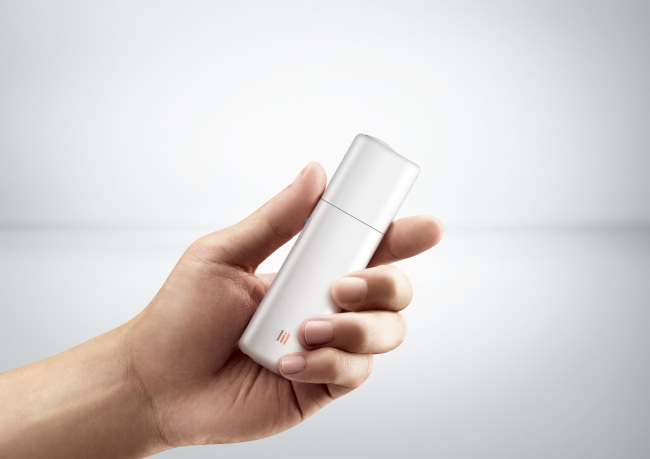[THE INVESTOR] KT&G has officially released its
first heat-not-burn tobacco product, also called e-cigarette, Lil, after
months of planning. The question now is whether Korea’s dominant
tobacco maker can lure smokers away from rivals like Philip Morris
International and British American Tobacco whose products have gained
market share.
Assuming that product quality is similar, prices will be a big factor determining KT&G’s success.
All e-cigarette makers are agonizing over whether to raise the price of their sticks after the National Assembly’s finance committee decided on Oct. 20 to raise consumption taxes to 90 percent of regular cigarettes from the current 50-60 percent.

The decision is pushing tobacco manufacturers to consider spiking prices to over 5,000 won (US$4.43) from the current 4,300 won per pack. KT&G is no exception to this dilemma. For now, Korea’s No.1 tobacco maker has decided to price its own sticks -- called Fiits -- at 4,300 won. “Since we’ve already announced the price of our product, it won’t be easy change things, regardless of regulations,” one official told The Investor.
The device powering the Fiits, however, is priced lower than those of its rivals PMI and BAT.
KT&G will also have to meet the demand for quality, as consumers seem satisfied with existing products available in the market, in particular the IQOS produced by PMI, which is leading the local e-cigarette market with over 5 percent share. KT&G is likely to use its brand recognition to fight the tide, according to industry watchers.
But it won’t all be smooth sailing, given similar cases overseas. Japan Tobacco -- one-third government owned -- launched its e-cigarette Ploom TECH in March 2016. The Japanese firm sought to catch-up with rival and first mover PMI, but is yet to achieve this goal.
Industry watchers say part of the reason JT failed to boost sales in the early stages was supply shortage, caused by insufficient manufacturing lines. “Our main priority is to ramp up our manufacturing capacity,” JT spokesperson Eva Hoeffelman told The Investor.
Seeing the situation in Japan, KT&G has been working on supply stability.
“We are trying to prepare adequate supplies before launch to satisfy the growing demand,” said KT&G marketing executive Oh Chi-beum on Oct. 26 during a press briefing on the firm’s third-quarter earnings.
In the meantime, competitors are getting ready to defend and further expand their market share here.
“We plan to increase out production capacity to meet growing demand. We are considering many countries, and Korea is definitely on our list,” a Philip Morris Korea spokesperson said.
In June, BAT expanded its plant in Sacheon, South Gyeongsang Province, and also established its first production plant in Korea for making Neostiks for its e-cigarette device Glo.
Last but not least, whether KT&G can overcome patent issues will also determine the future of its products. JT has opted for tobacco capsules over cigarette sticks to eliminate potential patent disputes. Industry sources say KT&G’s LIL is likely to take the form of sticks, which could trigger patent clashes.
Currently, PMI has 678 HNB cigarette related patents and BAT has more than 600 in Korea. Industry sources are of the view that KT&G may have to take the risk of infringing on some of these patents to make Lil more marketable.
The Korean tobacco maker has expressed confidence in its indigenous technology. Nevertheless, PMI and BAT have said they will thoroughly review Lil to see whether it violates their patents.
By Song Seung-hyun (ssh@heraldcorp.com)
Assuming that product quality is similar, prices will be a big factor determining KT&G’s success.
All e-cigarette makers are agonizing over whether to raise the price of their sticks after the National Assembly’s finance committee decided on Oct. 20 to raise consumption taxes to 90 percent of regular cigarettes from the current 50-60 percent.

The decision is pushing tobacco manufacturers to consider spiking prices to over 5,000 won (US$4.43) from the current 4,300 won per pack. KT&G is no exception to this dilemma. For now, Korea’s No.1 tobacco maker has decided to price its own sticks -- called Fiits -- at 4,300 won. “Since we’ve already announced the price of our product, it won’t be easy change things, regardless of regulations,” one official told The Investor.
The device powering the Fiits, however, is priced lower than those of its rivals PMI and BAT.
KT&G will also have to meet the demand for quality, as consumers seem satisfied with existing products available in the market, in particular the IQOS produced by PMI, which is leading the local e-cigarette market with over 5 percent share. KT&G is likely to use its brand recognition to fight the tide, according to industry watchers.
But it won’t all be smooth sailing, given similar cases overseas. Japan Tobacco -- one-third government owned -- launched its e-cigarette Ploom TECH in March 2016. The Japanese firm sought to catch-up with rival and first mover PMI, but is yet to achieve this goal.
Industry watchers say part of the reason JT failed to boost sales in the early stages was supply shortage, caused by insufficient manufacturing lines. “Our main priority is to ramp up our manufacturing capacity,” JT spokesperson Eva Hoeffelman told The Investor.
Seeing the situation in Japan, KT&G has been working on supply stability.
“We are trying to prepare adequate supplies before launch to satisfy the growing demand,” said KT&G marketing executive Oh Chi-beum on Oct. 26 during a press briefing on the firm’s third-quarter earnings.
In the meantime, competitors are getting ready to defend and further expand their market share here.
“We plan to increase out production capacity to meet growing demand. We are considering many countries, and Korea is definitely on our list,” a Philip Morris Korea spokesperson said.
In June, BAT expanded its plant in Sacheon, South Gyeongsang Province, and also established its first production plant in Korea for making Neostiks for its e-cigarette device Glo.
Last but not least, whether KT&G can overcome patent issues will also determine the future of its products. JT has opted for tobacco capsules over cigarette sticks to eliminate potential patent disputes. Industry sources say KT&G’s LIL is likely to take the form of sticks, which could trigger patent clashes.
Currently, PMI has 678 HNB cigarette related patents and BAT has more than 600 in Korea. Industry sources are of the view that KT&G may have to take the risk of infringing on some of these patents to make Lil more marketable.
The Korean tobacco maker has expressed confidence in its indigenous technology. Nevertheless, PMI and BAT have said they will thoroughly review Lil to see whether it violates their patents.
By Song Seung-hyun (ssh@heraldcorp.com)
on Thu, 11/09/2017 - 22:32 admin



